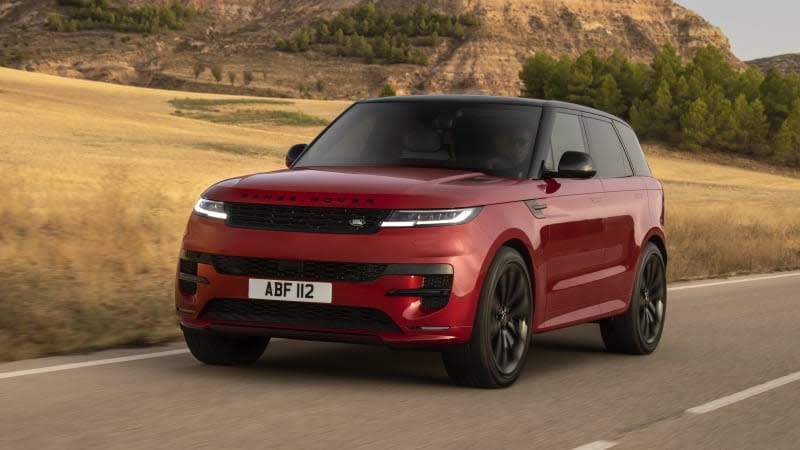2023 Range Rover Sport First Drive: Ostentation on the eve of electrification

MADRID, Spain — The 2023 Range Rover Sport marks several firsts for Land Rover’s luxury-first sub-brand. It’s the first time the sportier take on Land Rover’s iconic luxury SUV is being offered with multiple hybrid powertrains and will become the first to be offered as a pure battery-electric. This generation also brings with it a shift from Land Rover’s tried-and-true (but simultaneously aged) 5.0-liter supercharged V8 to a twin-turbo V8 sourced from BMW. Not many cars are worth crossing an ocean just to test drive, but the new Range Rover Sport makes a convincing case.
So, what puts the “Sport” in Range Rover Sport? A few things, some sportier than others. The platform is shared, but they are separate models for reasons beyond marketing. The Sport is available only in a two-row configuration whereas The Range Rover offers regular wheelbase two-row and long-wheelbase three-row variants. The Sport’s design lives up to its name with a narrower grille and headlights, full-width taillight trim and more greatly pinched rear roofline that’s altogether less stately and more streamlined (pictured below left with The Range Rover below right). It also comes with a less-powerful base engine (more on that later). Most critically, it’s cheaper — by about $20,000. There aren’t any major mechanical differences to explain that, nor a radically different equipment list, but harder-to-quantify, attention-to-detail elements likely play a role. The Sport doesn’t get “the most powerful LED taillamps ever made,” for example.


Dimensions aren’t appreciably different, which means the Sport is pretty much the largest vehicle you can comfortably weave through the urban hedge maze that is Madrid. In this part of the world, the most substantial passenger car you’ll typically see on the road is something like a Toyota RAV4. I saw more pickups roaming the airfield when my 767 touched down at Barajas International than I would spot throughout the duration of the trip. Two lifted wheelers – a Nissan Patrol and an old Land Cruiser – were the only properly “big” SUVs on the road. The next runner-up? A lonely Porsche Cayenne Coupe.
At 80-plus inches wide, the Rover kisses paint on either side of these narrow business district lanes. For once, my upbringing in an old (by American standards) East Coast town pays dividends, and the Range Rover’s myriad electronic whiskers were surprisingly tolerant of my comfort with putting bits of the car just an inch or two from 400-year-old stonework. Nary a curb was kissed.
Slinking through these narrow alleyways-cum-boulevards in a thicc SUV with an even thiccer price tag (on 23-inch wheels, no less) could be nerve-wracking. Despite its relative size, though, it was easy to feel out the Range Rover’s corners. It drives a bit smaller than its size suggests — a characteristic further augmented by its rear-wheel steering. Pedestrians own these cobbled passageways, rarely looking up from their phones or away from their companions before stepping off the curb. We admittedly do far better than most at getting some of their attention, so if you want to make a scene in Madrid, just show up in a Range Rover.



The transition to farmland and industrial space happens abruptly. There’s no step down to the vast sprawl we’re used to outside American urban centers, just a snap cut from multistory commie-style blocks built atop single-story parking shelters to virtual emptiness. It’s dry — uncommonly so, locals and frequent visitors tell us. Our safety briefing included a note to avoid parking on or near patches of grass when venturing off the route in search of photo backdrops.
As the roads open and we put the last of the speed cameras behind us, the Range Rover greedily devours asphalt with a deep growl. We’re in the P530 First Edition, with its thumping, BMW-sourced V8 and dynamic-everything chassis. Despite its German heart, this is the most American of the three models we’re due to receive stateside. The twin-turbo 4.4-liter V8 makes 523 horsepower and 553 pound-feet of torque; Land Rover claims it will take the Sport to 60 in 4.3 seconds. Out here, that translates to “just in time to slow down for the next corner.” These roads aren’t bad; they’d just be better in a car half this size.
The V8 both sounds and feels just a tad coarse, likely to invoke the character of Range Rover’s now-departed supercharged 5.0-liter unit. But as befits its modern engineering, the big twin-turbo eight has a robust and flexible powerband, meaning that beneath that rough-and-tumble demeanor it feels very no-nonsense. The air suspension does a reasonable job at both extremes. Firm it up and the nose will tuck obediently into a corner, at least to a point. This is a 5,500-pound SUV, but if the “Sport” part matters more to you than the “Range Rover” part, this is the one you want.
The lanes in Spain may cause a wider SUV pain, but the asphalt itself is blissfully smooth. This spared the 23-inch wheels from putting a foot wrong and let the Range Rover Sport’s air suspension positively shine. Sure, this may have been easy mode for the big SUV but I’m still inclined to give it excellent marks for ride quality. I’m the sort of geek who’s happy with a set of 18-inchers so long as they’re wearing the right compound, but for big, heavy wheels wrapped in what amounts to a few layers of saran wrap, these aren’t half-bad.

 Yahoo Autos
Yahoo Autos 
